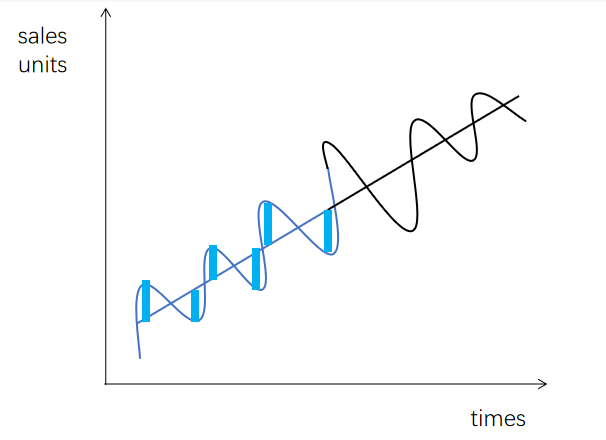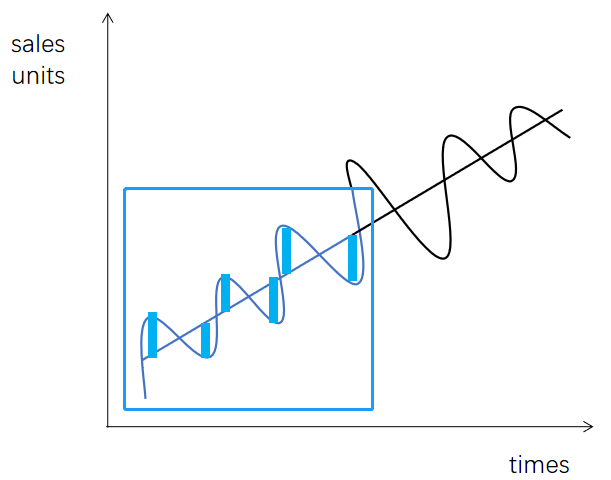在ACCA考试中,F2阶段时间序列知识点一直都是比较重要且每年都会出现在试卷里,今天会计网就跟大家详解这个知识点内容。

01、时间序列的组成部分,及局限性
1.1)Time series can be broken down into 4 categories:
a) Trend.(趋势)
Key words: underlying long-term movement
√ 根据当下actual sales,通过数学计算得出大致销售趋势。
即:默认现行趋势在未来也适用。
b) Seasonal variation.(季节性变动)
Key words: short-term fluctuations
affect results at different times of the year
√ 在时间上不一定是按“季节”发生的偏差,可以是每天的或每周的有规律的偏差。
即:短期内有规律的偏差都可归为季节性变动。
c) Cyclical variation.(周期性变动)
Key words: longer time period
√ 相对于季节性变动,它是长期的有规律的变动,比如:经济周期。
d) Random variation. (随机性变动)
Key words: unforeseen circumstances
√ 通常不可预见,比如:政变、战争。
由于是突发事件,所以在做预测时(forecasting)不考虑该元素。
Ps:在F2中做Time series计算题时,不考虑Cyclical variation,到了P level才会涉及。
1.2)时间序列计算的局限性源于3个前提假设
a. a straight-line trend exists.
b. seasonal variations are constant.
c. what has happened in the past is a reliable guide to the future
因此,如果事件的发生带有不可预见性,则不适用这种方法。
02、时间序列的组成部分——Trend计算
第1步:用moving average方法平滑actual sales units注意:偶数的时间跨度比奇数的时间跨度多一步计算!a) 当时间跨度是奇数时(以3年时间跨度为例)

b) 当时间跨度是偶数时(以4年时间跨度为例)

第2步:actual sales units被平滑后,根据high-low method 求出Trend表达式,即:Y=a + b XY(因变量)=Trend,X(自变量)=时间,一个X代表一个时间跨度注意:时间是自变量,trend是因变量!所以根据high-low method的计算原则,先选出时间(X)最大值和最小值,再找到对应trend(Y)的值,求出表达值即可
以第1步中3年时间跨度为例:假设20X1在X轴上代表1,往后每一年都依次共一个数字代表,则20X5 在X轴上代表5通过X找到对应Y的值,则得到两个点(1,410);(5,470)求的Y=395+15X
辨析:图中倾斜向上的直线就是trend表达式在坐标轴上的体现。这条直线没有具体的X范围规定(即:时间序列计算的前提假设,暗含现在的趋势以后仍将继续)为了便于理解可以将时间序列分解成两部分来看
1)当下状况(actual)
图中蓝色曲线是actual units,根据前面两个步骤的计算得到蓝色倾斜直线。即:现有状况下的趋势
2)预测未来(forecasting)
图中黑色倾斜直线,是蓝色倾斜直线的延长线,延续现有趋势,代表未来趋势再根据给出的蓝色粗实线调节对应季节性波动,得到黑色曲线 Forecasting figure

03、时间序列的组成部分——Trend + Seasonal variation计算
涉及2元素:Y= Forecasting figure T= TrendS= Seasonal variation上图中蓝色实线,是在求出的trend上调整季节性波动,最终得到Forecasting figure(Y)a) 加法模型的计算公式Y = T + S例子1: Based on the last 15 periods the underlying trend of sales is y = 345.12 – 1.35x. If the 16th period has a seasonal factor of –23.62, assuming an additive forecasting model, what is the forecast for that period, in whole units?解:将x=16代入y = 345.12 – 1.35x,得到y=323.52.这里的y,就是trend。所以在加法模型中对应T=323.52又已知S=–23.62代入公式得到Y=323.52+(–23.62)=299.9
b) 乘法模型的计算公式Y = T * S例子2: The trend for monthly sales ($Y) is related to the month (t) by the equation Y = 1,500 – 3t where t = 0 in the first month of 20X8. What are the forecast sales (to the nearest dollar) for the first month of 20X9 if the seasonal component for that month is 0.92 using a multiplicative model?解:这里t=0对应 20X8 month1,一年有12个月则20X9 month1,对应t=12 (12+0=12) 代入 Y = 1,500 – 3t,求的Y=1464,这里的Y,就是trend。所以在乘法模型中对应T=1464又已知S=0.92代入公式得到Y=1464*0.92=1346.88
c) 两种模型下季节性变动求和以一年为一个周期,中间有n个季节性波动时间点1) 加法模型∑ Δ S=0即:一年内,n个季节性波动相加=0例子3:The multiplicative quarterly seasonal variations for the time series were as follows:

以一年为一个周期,中间有4个季节性波动时间点,相加=00.82+1.41+?+(-1.09)=0求得?=-1.14 2) 乘法模型∑ Δ S=n即:一年内,n个季节性波动相加=n例子4:The multiplicative quarterly seasonal variations for the time series were as follows:

以一年为一个周期,中间有4个季节性波动时间点,相加=40.82+1.41+?+1.09=4求得?=0.68Ps :在乘法模型中不可能出现某个季节性波动系数是负的的情况
04、Deseasonalization(去季节化因素)计算
“seasonally adjusted”是”Deseasonalization”的同义词辨析:该知识点可以理解为是以上知识点的逆向思维,不涉及forecasting即:已知actual units,和去季节化因素后,得到当下trend结合图形理解:给出蓝色曲线(actual units),和季节性波动系数(蓝色粗实线),求蓝色倾斜直线上的点

加法模型:T=Y-S乘法模型:T=Y/SY =the actual sales units S =Seasonal variationT =seasonally adjusted trend = current trend例子5:In January, the unemployment in Ruritania is 567,800. If the seasonal factor using an additive time series model is +90,100, what is the seasonally-adjusted level of unemployment (to the nearest whole number)?加法模型:T=Y-S =567,800-90,100=477,700
来源:ACCA学习帮



















